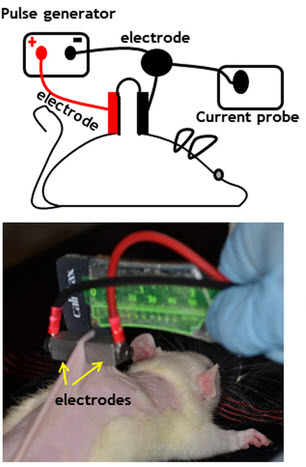Pulsed electric field technology may rejuvenate skin function and appearance
June 30, 2015
A team of Tel Aviv University and Harvard Medical School researchers has devised a novel non-invasive tissue-stimulation technique using pulsed electric fields (PEF) to generate new skin tissue growth.
The technique produces scarless skin rejuvenation and may revolutionize the treatment of degenerative skin diseases, according to research team leader Alexander Golberg of TAU’s Porter School of Environmental Studies and the Center for Engineering in Medicine at Massachusetts General Hospital, Harvard Medical School, and Shriners Burns Hospital in Boston.
“Pulsed electrical field technology has many advantages, which have already proved effective — for example, in food preservation, tumor removal, and wound disinfection,” said Golberg. “Our new application may jumpstart the secretion of new collagen and capillaries in problematic skin areas.
Current therapies to rejuvenate skin use various physical and chemical methods to affect cells and the extracellular matrix, but they induce unsightly scarring.
How it works
Pulsed electric fields, however, affect only the cell membrane itself, preserving the extracellular matrix architecture and releasing multiple growth factors to spark new cell and tissue growth, according to the researchers.
By inducing nanoscale defects on the cell membranes, electric fields cause the death of a small number of cells in affected areas, but the released growth factors increase the metabolism of the remaining cells, generating new tissue.
“We have identified in rats the specific pulsed electric field parameters that lead to prominent proliferation of the epidermis, formation of microvasculature, and secretion of new collagen at treated areas without scarring,” said Dr. Golberg. “Our results suggest that pulsed electric fields can improve skin function and potentially serve as a novel non-invasive skin therapy for multiple degenerative skin diseases.”
The research is described in an open-access paper published in Scientific Reports. Other researchers include William J. Austen, Jr. from the Department of Plastic Surgery at Massachusetts General Hospital and Martin L. Yarmush at the Center for Engineering in Medicine at Massachusetts General Hospital, Harvard Medical School, and Shriners Burns Hospital in Boston, along with other prominent researchers.
The researchers are currently developing a low-cost device for use in clinical trials to test the safety and efficacy of the technology in humans.
The researchers note that degenerative skin diseases affect one in three adults over the age of 60. Americans spend over $10 billion a year on products and surgery in their quest to find a “fountain of youth,” with little permanent success. Botulinum toxin — notably Botox — which smoothes lines and wrinkles to rejuvenate the aging face has been the number one nonsurgical procedure in the U.S. since 2000. But injections of this toxic bacterium are only a temporary solution and carry many risks, some neurological.
Abstract of Skin Rejuvenation with Non-Invasive Pulsed Electric Fields
Degenerative skin diseases affect one third of individuals over the age of sixty. Current therapies use various physical and chemical methods to rejuvenate skin; but since the therapies affect many tissue components including cells and extracellular matrix, they may also induce significant side effects, such as scarring. Here we report on a new, non-invasive, non-thermal technique to rejuvenate skin with pulsed electric fields. The fields destroy cells while simultaneously completely preserving the extracellular matrix architecture and releasing multiple growth factors locally that induce new cells and tissue growth. We have identified the specific pulsed electric field parameters in rats that lead to prominent proliferation of the epidermis, formation of microvasculature, and secretion of new collagen at treated areas without scarring. Our results suggest that pulsed electric fields can improve skin function and thus can potentially serve as a novel non-invasive skin therapy for multiple degenerative skin diseases.
